
3.7. Group III without feedback and without rule (fr n=24)
3.7.1. First fifty and last fifty trials:
Figure (3.7.1.) shows the top view cartoon brainmaps for the subtraction of the grand averaged ERPs elicited by the learners last fifty answer trials minus the first fifty answer trials. There were no significant differences from 500msec pre-stimulus and up to 200msec post-stimulus. The positivity for the last fifty subtractions is all over the right-hand side of the brainmaps over the frontal, temporal, central and parietal areas from 200msec. The positive activity localized over the frontal area bilaterally and central area, by the time changed to be right-hand side of the frontal and anterior temporal areas of the brainmaps. 1000msec post-stimulus the brain activity did not show significant changes.

Figure (3.7.1.) shows the top view cartoon brainmaps made from subtraction of the first fifty answers trials from the last fifty answers trials grand average ERPs elicited by the learners performance in group three (Lfr). The numbers below each brainmap indicates the time in milliseconds when the map was computed. These results indicate 200 msec before stimulus to 1452 msec after stimulus. Color scale displays brain potentials from +15
m n in pink color, and –15 m n in dark blue. Frontal area to the top and occipital to the bottom of the brainmaps.Figure (3.7.2.) shows the top view cartoon brainmaps made from subtraction of the first fifty answers trials from the last fifty answers trials grand average ERPs elicited by the non-learners performance (nLfr). These results indicate 200msec pre-stimulus where we did not notice any significant brain activity. There was not much difference between the first fifty and the last fifty post-stimulus up to about 250msec. There was little significant positive brain activity pre-stimulus until 250msec post-stimulus located over the frontal area, the parietal area, and the occipital area bilaterally and the posterior temporal area. The activity differences were gradually decreased from about 500msec. The positive and negative activity over the brain areas from 500msec up to the end of the task did not show any significant differences.

Figure (3.7.2.) shows the top view cartoon brainmaps made from subtraction of the first fifty answers trials from the last fifty answers trials grand average ERPs elicited by the non-learners performance in group three (nLfr). The numbers below each brainmap indicates the time in milliseconds when the map was computed. These results indicate 200msec before stimulus to 1452msec after stimulus. Color scale displays brain potentials from +15
m n in pink color, and –15 m n in dark blue. Frontal area to the top and occipital to the bottom of the brainmapsA comparison was made of the grand averaged event related potential waveforms for the last fifty trials and the first fifty trials in the learners (Lfr) and the non-learners (nLfr). The waveforms showed quite clearly the similarity of the waveform before the onset of the stimulus, and then the differences in ERPs. The initial potentials were the same up to 220msec post-stimulus in particular with respect to amplitude. The learners showed that the waveforms from about 250msec of the last fifty answer trials showed more positivity than the first fifty trials. The positive peak amplitudes were higher for the last fifty stimuli than for the first fifty stimuli. The non-learners traces for the first fifty answer trials and the last fifty answer trials did not show obvious significant differences. The trace morphology showed that both traces had the same positive and negative peaks (Figures 3.7.3a).
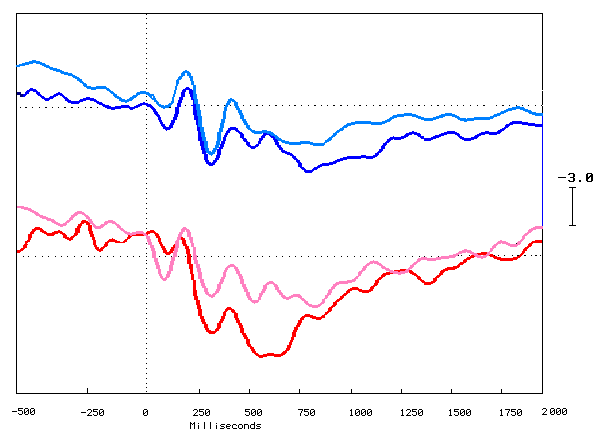
Figure (3.7.3a) Grand average ERPs elicited by the non-learners last fifty trials in blue color and the first fifty in light blue color represented by the top traces and The learners' last fifty trial traces in red color, the first fifty trials in light red color presented by the bottom traces. Recorded at FZ, Y-axis shows amplitude in Microvolts (
m n ), and X-axis shows latency in milliseconds (ms). The black vertical dotted line marks the point of stimulus onset, and the horizontal black dotted line represents the baseline. Upward deflection represents the negativity.Figure 3.7.3b shows that the learners and non-learners last fifty answer trials traces were similar pre-stimulus and up to 250msec post-stimulus. The positive going peak were very clear and looked significantly different (Top traces). The learners and non-learners first fifty answer trials were quite similar pre and post stimulus in positive and negative peaks morphology and amplitudes.
There were numbers of other significant observations. Firstly, the differences in the positive peak amplitudes between the last fifty and first fifty stimuli were more persistent in the right hemisphere. Secondly, the maximum amplitude for the positive peaks were recorded at the frontal electrode Fz and the positive peak component for last fifty stimuli showed a more enhanced positivity than for first fifty stimuli. Finally, the peak latencies of positive components were slightly later for the last fifty-answer trial.
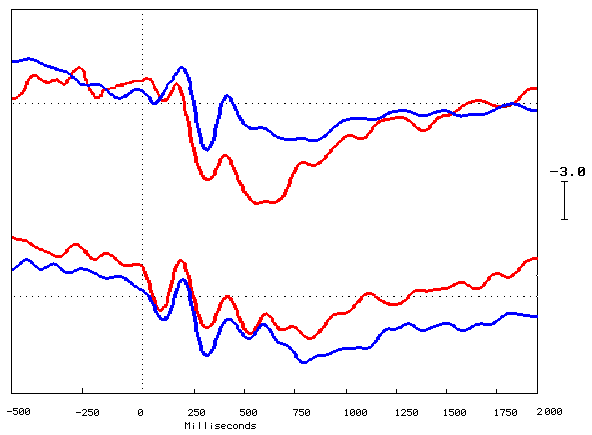
Figure (3.7.3b) Grand average ERPs elicited by the non-learners trial traces in blue color and the learners' trial traces in red color. The top traces represent the last fifty; the bottom traces represent the first fifty. Recorded at FZ, Y-axis shows amplitude in Microvolts (
m n ), and X-axis shows latency in milliseconds (ms). The black vertical dotted line marks the point of stimulus onset, and the horizontal black dotted line represents the baseline. Upward deflection represents the negativity.3.7.2. Correct versus incorrect answer trials
Figure 3.7.4a shows the grand average event related potential traces elicited by the learners and non-learners subject’s performance during the correct and the incorrect answer trials. The pre-stimulus part was similar and did not show any significant differences. Post-stimulus and up to 280msec did not show significant differences and the traces were similar in positive and negative deflections. The learners correct answer trials trace showed more positive differences than the non-learners. Incorrect answers trial traces for the both groups did not show any differences.
The learners correct and incorrect answer trials compared together and showed a more positive going peak from about 300msec up to 800msec post-stimulus when they return back to be similar to the first stage of recording and pre-stimulus. The non-learners correct answer trials trace and the incorrect answer trials showed no morphological or amplitude differences.
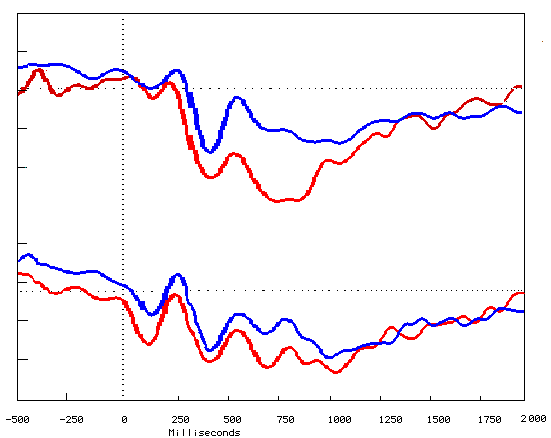
Figure (3.7.4a) Grand average ERPs elicited by the learners in red color and non-learners in blue color. The correct answer trials represented by the top traces and the incorrect answers trials represented by the bottom traces. Recorded at FZ, Y-axis shows amplitude in Microvolts (
m n ), and X-axis shows latency in milliseconds (ms). The black vertical dotted line marks the point of stimulus onset, and the horizontal black dotted line represents the baseline. Upward deflection represents the negativity.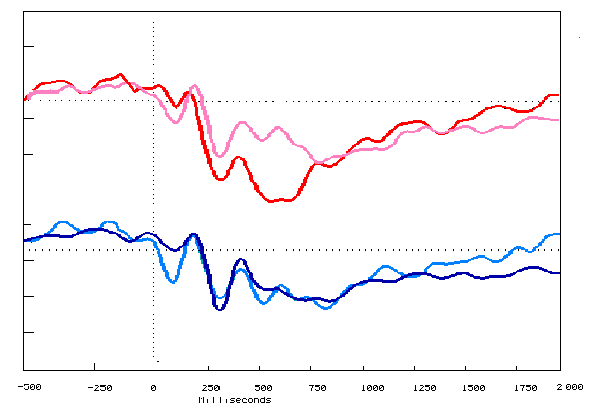
Figure (3.7.4b) Grand average ERPs elicited by the learners correct answer trials in red color, the incorrect trials in light red color represented by the top traces and the non-learners correct answer trials in blue color, the incorrect trials in light blue color, represented by the bottom traces. Recorded at FZ, Y-axis shows amplitude in Microvolts (
m n ), and X-axis shows latency in milliseconds (ms). The black vertical dotted line marks the point of stimulus onset, and the horizontal black dotted line represents the baseline. Upward deflection represents the negativity.
Figure 3.7.5a shows the learners correct answer trials cartoon brainmaps where there were no significant brain activities over all the brain areas from 200msec pre-stimulus. The post-stimulus positive activity appeared over the occipital and parietal and the negative activity over the frontal areas bilaterally.
The positive activities became frontally bilateral especially to the right-hand side and over the anterior temporal area from about 350msec. The negative activity replaced the positive activity over the parietal, occipital and the posterior temporal areas bilaterally about 350msec up to 900msec post-stimulus. The positive and negative activities decrease gradually to the end of the task. Generally the brain activity was more for the correct answers trials than the incorrect answers trials.
Figure 3.7.5b shows the cartoon brainmaps of the learners incorrect answers trials where there was no remarkable significant positive or negative brain activity 500msec pre-stimulus to about 200msec post-stimulus. There was frontal negativity then positivity from 250msec up to 900msec post-stimulus especially to the right-hand side.
Parietal, occipital, and posterior temporal positivity changed to negativity bilaterally about 350msec post-stimulus. The brain significant activity decreased gradually from 1000msec to the end of the task, and was less than the correct answer trials activity

Figure (3.7.5a) shows the top view cartoon brainmaps of made from the grand average ERPs elicited by the learners correct answer trials. The numbers below each brainmap indicates the time in milliseconds when the map was computed. These results indicate 200msec before stimulus to 1452msec after stimulus. Color scale displays brain potentials from +15
m n in pink color, and –15 m n in dark blue. Frontal area to the top and occipital to the bottom of the brainmaps
Figure (3.7.5b) shows the top view cartoon brainmaps of made from the grand average ERPs elicited by the learners incorrect answer trials. The numbers below each brainmap indicates the time in milliseconds when the map was computed. These results indicate 200msec before stimulus to 1452msec after stimulus. Color scale displays brain potentials from +15
m n in pink color, and –15 m n in dark blue. Frontal area to the top and occipital to the bottom of the brainmaps3.7.3. Regional differences
Furthermore, these figures clearly show a very marked front-occipital difference. The activity was more positive going over the frontal, the parietal, and the temporal areas especially on the right-hand side electrodes.
The brain potentials elicit more positive activity on the right hemisphere at frontal sites and propagated to the central and parietal sites on both hemispheres.
Figures (3.7.6a & b) shows the right-hand side and the left-hand side view cartoon brainmaps of the event related potentials elicited with the learners group during the last fifty answers trials. The positive activity started occipitally post-stimulus and then propagated over the parietal lobe area. The frontal area shows more positive activity at 200msec post-stimulus but it did not stay longer than 800msec. The frontal area on the right hand side view cartoon map shows more late positivity and stayed longer than the left-hand side.
Figures (3.7. 7a & b) showed the comparison between cartoon brainmap the right-hand side view versus the left-hand side view for the last fifty answer trials during the two time windows 250msec-550msec and 550msec-850msec.
The positive activity was localized frontally and distributed backward to the anterior temporal and was more for the right-hand side view brainmaps during both time windows when compared to the left-hand side view. The activity distributed over the parietal, the central, the posterior temporal and the occipital areas which means that these areas were involved in the trials performance by the value during this experiment condition trials and during the both windows. The positive activities were more for the right-hand side view large map during the first time window and for the left-hand side view large map during the second time interval window 550msec.

Figure (3.7.6a) shows the left-hand side view cartoon brainmaps of the ERP elicited with the learners group last fifty answers trials. The numbers below each brainmap indicates the time in milliseconds when the map was computed. These results indicate 200msec before stimulus to 1500msec after stimulus. Color scale displays brain potentials from +15
m n in pink color, and –15 m n in dark blue.Table (3.7.1.) shows the comparison between the right-hand side with the left-hand side electrodes for the learners during the last fifty trials. There were statistically significant differences for the frontal area electrodes F8-F7 and the anterior temporal area electrodes ATR-ATL during the two time windows.

Figure (3.7.6b) shows the right-hand side view cartoon brainmaps of the ERP elicited with the learners group last fifty answers trials. The numbers below each brainmap indicates the time in milliseconds when the map was computed. These results indicate 200msec before stimulus to 1500msec after stimulus. Color scale displays brain potentials from +15
m n in pink color, and –15 m n in dark blue.
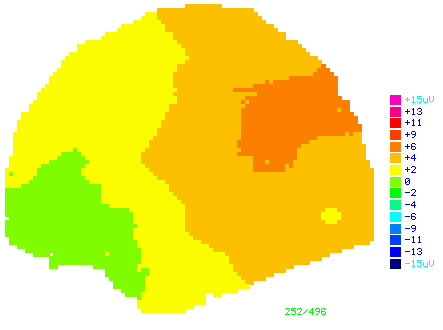
Figure 3.7.7a. Shows the left-hand side spatial maps made from the grand average ERP elicited with last fifty answer trials for the learners. The numbers below each large map indicates the time in milliseconds when the map was computed. The first time interval 250msec to 550msec and the second time interval 550msec to 850msec post-stimulus. Color scale displays brain potentials from +15
m n in pink color, and –15 m n in dark blue.
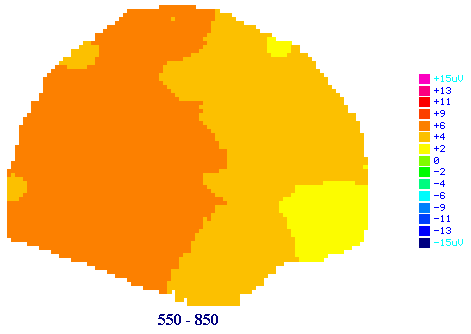
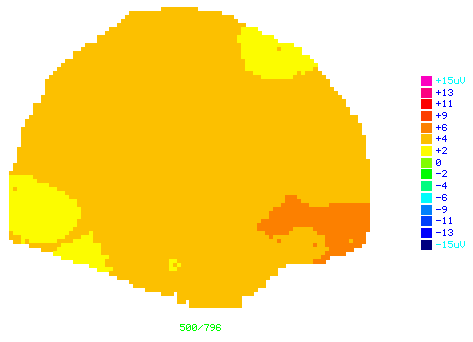
Figure (3.7.7b) shows the right-hand side spatial maps made from the grand average ERP elicited with last fifty answer trials for the learners group. The numbers below each large map indicates the time in milliseconds when the map was computed. The first time interval 250msec to 550msec and the second time interval 550msec to 850msec post-stimulus. Color scale displays brain potentials from +15
m n in pink color, and –15 m n in dark blue.The comparison between the individual right-hand side versus the left-hand side electrodes for the learners during the last fifty answer trials. The frontal, lateral central and parietal lateral electrodes (Figure 3.7.8a). The lateral frontal and the anterior temporal electrodes (Figure 3.7.8b). The temporal and the temporal-parietal (Figure 3.7.8c)
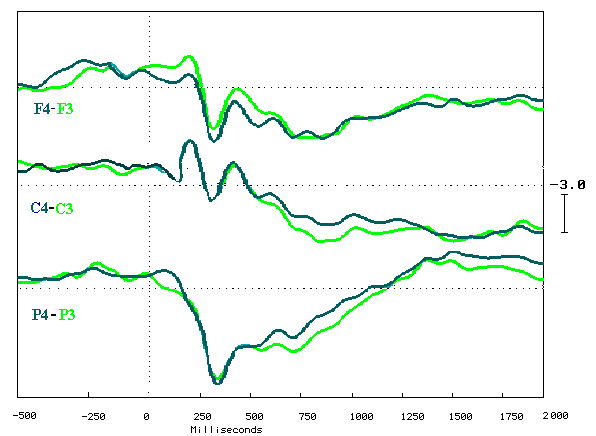
Figure (3.7.8a) shows the grand average ERPs elicited by the learner's last fifty answer trials. The left–hand side electrodes sites traces in light green color, the right-hand side electrodes sites traces in dark green color. Recorded at F4-F3, C4-C3, and P4-P3 Y-axis shows amplitude in Microvolts (
m n ), and X-axis shows latency in milliseconds (ms). The black vertical dotted line marks the point of stimulus onset, and the horizontal black dotted line represents the baseline. Upward deflection represents the negativity.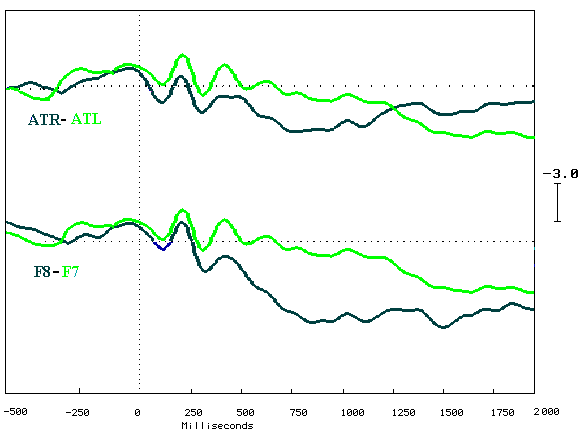
Figure (3.7.8b) shows the grand average ERPs elicited by the learner's last fifty answer trials. The left–hand side electrodes sites traces in light green color, the right-hand side electrodes sites traces in dark green color. Recorded at F8-F7 and ATR-ATL, Y-axis shows amplitude in Microvolts (
m n ), and X-axis shows latency in milliseconds (ms). The black vertical dotted line marks the point of stimulus onset, and the horizontal black dotted line represents the baseline. Upward deflection represents the negativity.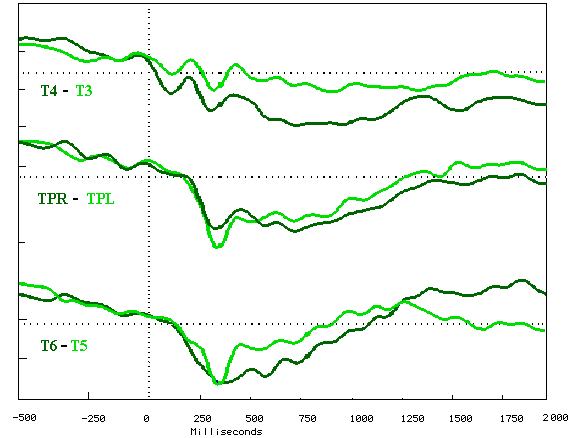
Figure (3.7.8c) shows the grand average ERPs elicited by the learner's last fifty trials. The left–hand side electrodes sites traces in light green color, the right-hand side electrodes sites traces in dark green color. Recorded at T4-T3, TPR-TPL and T6-T5, Y-axis shows amplitude in Microvolts (
m n ), and X-axis shows latency in milliseconds (ms). The black vertical dotted line marks the point of stimulus onset, and the horizontal black dotted line represents the baseline. Upward deflection represents the negativity.
|
Group |
Learners (LFR n=15) |
|
|
Electrodes sites |
1st window t value |
2nd window t value |
|
C4 - C3 |
0.88 |
0.97 |
|
F4 - F3 |
1.06 |
1.59 |
|
F8 - F7 |
2.91 * |
3.15 ** |
|
O2 - O1 |
1.01 |
0.99 |
|
P4 - P3 |
1.02 |
1.33 |
|
TPR - TPL |
1.18 |
1.08 |
|
T4 - T3 |
0.93 |
1.20 |
|
T6 - T5 |
1.65 |
0.95 |
|
AT - ATL |
2.38 * |
2.99 ** |
Table 3.7.1. Paired T-test results of the right-hand side versus the left-hand side electrodes for the last fifty trials (4th quartile) during both time windows